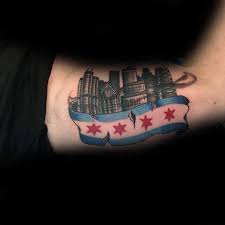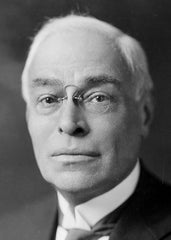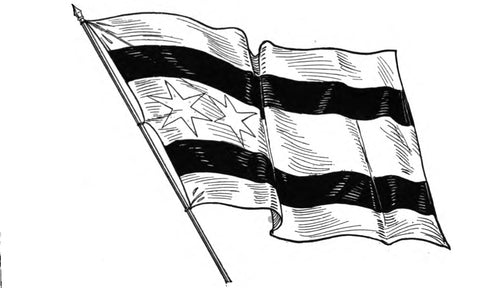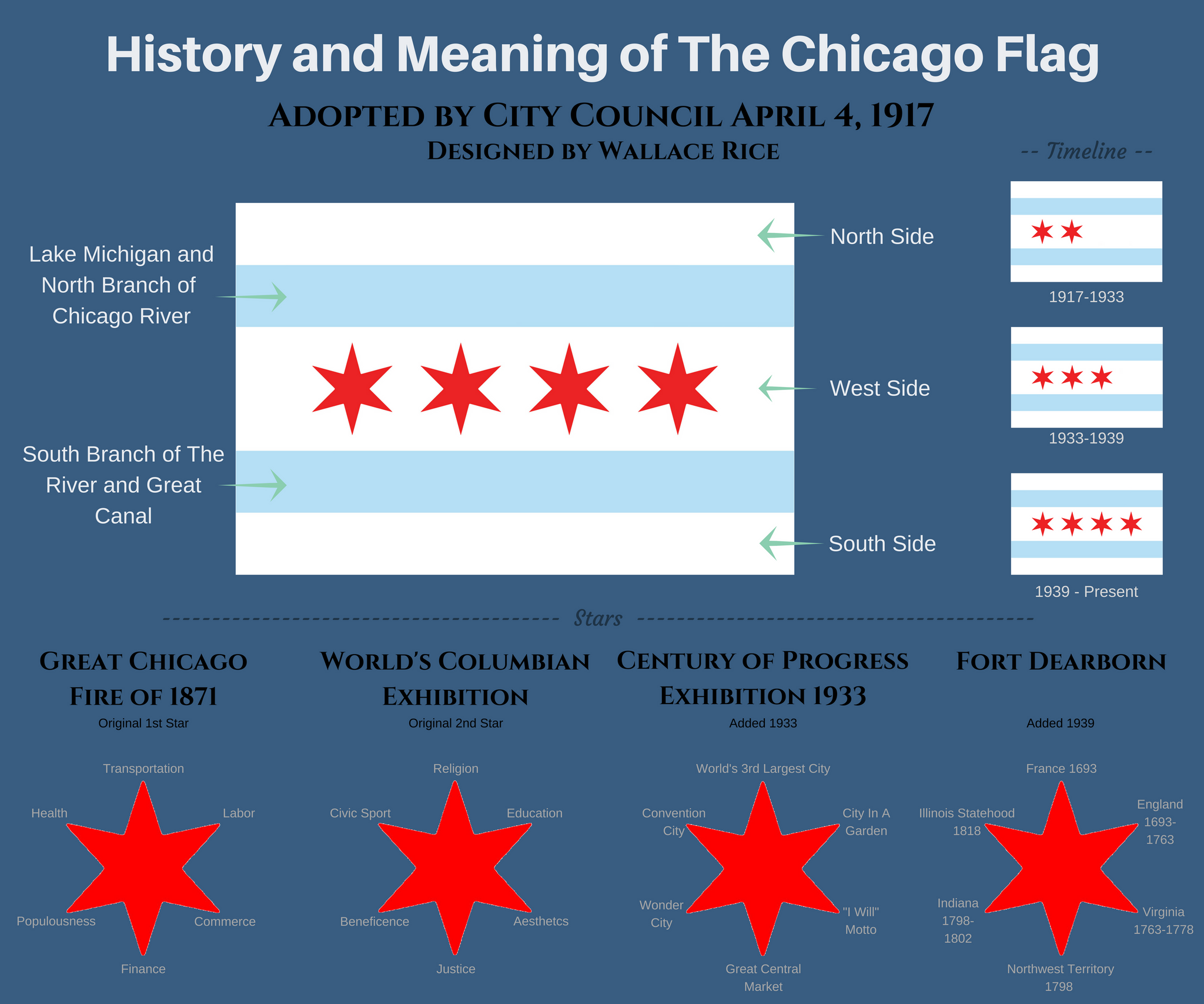Add description, images, menus and links to your mega menu
A column with no settings can be used as a spacer
Link to your collections, sales and even external links
Add up to five columns
Add description, images, menus and links to your mega menu
A column with no settings can be used as a spacer
Link to your collections, sales and even external links
Add up to five columns

Why is the Chicago Flag So Popular? And What Does It Mean?
8 min read
My Mom visited recently and we discussed the Chicago flag. Mom has visited a thousand times , so when she asked “Chicago has a flag? I don’t know what it looks like."
Well, I nearly fell off my stool.
If you live here - you know - the flag is everywhere. As in ubiquitous!
Not only does it fly around the city freely, it graces more merchandise ( t-shirts, hats, mugs, art, etc.) than you can fathom.
Chicago didn't always have a flag and as recently as 60 years ago it was virtually unknown to most citizens. But presently, after popularity surged in the mid 1990's, Chicagoans are quite smitten and very proud of their Municipal Flag and all that it represents.
If you don’t notice it - virtually everywhere - just take a closer look at the citizens.
Most Popular City Tattoo In The World

Bold claim? Probably, but go ahead, prove me wrong.
According to an article in DNA info, one parlor owner in West town gets so many requests for Chicago flag ink that he created an informational poster to educate his clients.
According to Nick Colella, owner of Great Lakes Tattoo, "No one knew what it was about, but they wanted it, It drove me nuts."
He now sells the poster for $20.

Looking for inspiration? You can find more tattoos inspired by the flag in a blog called Chicago Flag Tattoos.
Who Designed the Chicago Flag
Contest #1
In 1892, organizers were preparing for the World's Columbia Exposition. Efforts were being made to decorate the fair grounds as well as the city.
Since there were no official colors or unifying symbols, the city officials and exposition organizers were looking for ideas. Francis Davis Millet was a local artist and supervisor of sculpture and painting for the exposition.

He expressed the situation this way:
"Almost all European cities have chosen colors, as the universities and colleges have done, and these are called the 'Municipal Colors.' Would it not be well now to see if the authorities of Chicago will not select a color or combination of colors as the 'Municipal Colors' for the city? If this is done, it will simplify the whole matter of civic decorations very much and afford a precedent which will, I am sure, be followed in all great cities of the Union." -MILLET
The idea was embraced and a contest was announced to choose colors for the city. In the following 10 days the Tribune received 892 entries.The winning entry was submitted by architect Alfred Jensen Roewad.
And so, the official Municipal colors adopted by the city were red and white.
Contest #2
In 1915 Alderman James A. Kearns felt the city was falling behind other world cities in terms of identity. He proposed that the City Counsel form the Chicago Municipal Flag Commission.
The Commission, steered by rules and contest guidelines governed by Wallace Rice received over 1000 entries to be considered. On April 4, 1917 - the same day the U.S. Senate voted to support U.S. entry into World War I - City Council approved the winning design. There were 63 "yeas" and zero dissents.

Ironically, the design chosen was submitted by none other than Wallace Rice himself.
What inspired the symbols and design of the Chicago Flag?
Three white bands, two blue stripes and four unique six-pointed red stars. Simple but not without thought.
Let's let Wallace Rice explain:
White
"White, the union of all the colors, to symbolize the union of all the races in the city of Chicago." RICE, Chicago Flag Designer
- Top white band: "This white stripe stands locally for the North Side, nationally for the Atlantic Coast, and terrestrially for the countries east and north of the United States."
- White center band (More than twice as wide as one of the blue bands): "This white bar stands locally for the West Side, nationally for the Great Central Plain dominated by Chicago, and terrestrially for the United States, in which the two stars signify Chicago is the second city, as well as the second city of the New World."
- Bottom white band: "This white stripe stands locally for the South Side, nationally for the Pacific Coast, and terrestrially for the countries west and south of the United States."
Blue
"Blue, the color of the lake and river, of distant mountains, and of the oceans." RICE, Chicago Flag Designer
- Upper blue band: "This blue stripe stands locally for the North Branch of the (Chicago) River, nationally for the Allegheny Mountains, and terrestrially for the Atlantic Ocean and Great Lakes." Rice also noted, "This stripe, with the other stripe and the two stars (on the original flag), indicates that Chicago is the fourth city of the globe."
- Lower blue band: "This blue stripe stands locally for the South Branch of the (Chicago) River, nationally for the Rockies and Sierras, and terrestrially for the Pacific Ocean and the Gulf of Mexico."

 Stars
Stars

Originally there were only two stars, pushed to the left, leaving room for more to be added in the future.

Each star symbolizes an event and each point adds even more to the story.
Star #1 represents the Great Chicago Fire of 1871
Points on this star represent ideas of excellence that the city holds dear.
- Transportation: "The city being now the greatest railway center in the world."
- Trade: "Both wholesale and retail, in many features of which the city bears the palm — as grain, mail orders and many more."
- Finance: "Being the second city in the country and perhaps in the would at this time in bank clearings and banking capital."
- Labor and industry: "The city's manufacturers in many lines being favorably known throughout the world."
- Populousness: "Being already the second city in the Americas and fourth in the world."
- Healthfulness: "Being the healthiest city of its size on earth."
Star #2 represents the World's Columbian Exposition of 1893
These points symbolize spiritual ideals.
- Religion: "Including cathedrals, churches, theological seminaries, schools for missionaries and many institutions of international rank in their respective denominations."
- Education: "With three universities, several colleges, two technical schools, great libraries on private foundations, in addition to the enormous public school system."
- Aesthetics: "With the new city plan for its beautification, the Art Institute, the Orchestra Hall and the Chicago Symphony Orchestra, the attention given architecture, music schools, art schools and much more of that nature."
- Beneficence: "Shown in hospitals, neighborhood parks, museums, charitable organizations and a hundred other things."
- Justice: "Exhibited in the Juvenile Courts, the Morals Court, the Court of Domestic Relations and other features in which Chicago has led the world in the application of the most modern methods to the prevention of crime and disorder and the reformation of those under the displeasure of society."
- Civism: "Or the feeling among our people of the need for good citizenship in order that the city may take first rank in everything of good repute."
Star #3 Was added Oct. 1933 to commemorate the Century of Progress International Exposition of 1933
Individual points represent Chicago's growing global presence.
- The world's third-largest city.
- "Urbs in Horto," Latin for "City in a Garden."
- "I Will," the city's motto.
- The Great Central Market.
- The Wonder City.
- The Convention City.
Star #4 was added in 1939 to honor Fort Dearborn
These points refer to the history and development of Chicago territory.
- French domination, 1693.
- English domination, 1693-1763.
- Territory of the state of Virginia, 1763-78.
- Part of Northwest Territory, 1778-98.
- Part of Indiana territory, 1798-1802.
- Illinois statehood, 1818.
This choice was controversial.
Many Chicagoans felt that it was a disgrace to honor the Fort Dearborn Massacre.
One historian, Kenan Heise said "the white Americans encamped at Ft. Dearborn had to do many things wrong to put the Pottawatomies on the warpath, and they did all of them."
* Side note... the meaning of the points is mostly unofficial. There are City Council records stating the intended meaning of the first two stars, but not the additional stars.

Available for reuse under Creative Commons with attribution.
What will the 5th star represent?
Some recent proposals include:
- French explorers Louis Joliet and Jacques Marquette
- Chicago's role in the nuclear age
- Richard J. Daley or Harold Washington
- Chicago Bulls 6 NBA Championships
- Hosting the 2016 Olympics (which didn't happen)
The Chicago History Museum has a permanent exhibit titled the Fifth Star Challenge posing this very question.

Did you know? A Chicago flag with a fifth star already exists?
Click here for the secret story the unknown 5-Star flag.

Why is the Chicago flag so popular?
'Cause it represents the "Windy City", has a ton of history, and looks pretty damn cool.
The North American Vexillological Association held an opinion survey in 2004.
Chicago’s Flag landed number 2 of 150—second only to Washington D.C.’s flag.
Here is our favorite:

Handmade from used denim. One of a kind. Inquire at Fine Line Flag.
Photo attributes:
Photo of Francis Davis Millet from Chicago Tribune Archives.
Photo of Wallace Rice from Chicago Tribune Archives.
Photo of Carl "Gus" Porter III holding 5 star flag:
WGN Flag and Decorating Co. owner Carl "Gus" Porter III drapes a five-star Chicago flag over his shoulder. His great-grandfather designed and made the flag when he thought the City Council planned to add a fifth-star to honor the late Mayor Richard J. Daley. Dna info article by Mark Konkol
Chicago Flag FAQs
What do the stars on the Chicago flag mean?
The Chicago flag consists of 4 red stars with 6 points each. Each star represents a major historical event. The first star on the left is to remember the Great Chicago Fire of 1871. The second star represents the World's Columbian Exposition of 1893.The 3rd star commemorates the Century of Progress International Exposition of 1933. And the final star was added in 1939 to honor Fort Dearborn.
What do the stripes on the Chicago flag mean?
The Chicago flag consists of three white bands, two blue stripes, and four six-pointed stars. Each white band represents a part of the city. The top band, the North side, the middle white band represents the West side of the city, and the bottom white band the South side of Chicago. The top blue stripe represents Lake Michigan and the North branch of the river. The bottom blue stripe, the South side of the Chicago river.
How old is the Chicago flag?
On April 4, 1917 - the same day the U.S. Senate voted to support U.S. entry into World War I - Chicago City Council approved the winning design and the Chicago flag was official. The Chicago flag is now over 100 years old.
What is a Chicago resident called?
Chicago residents are commonly called Chicagoans.
What is the Chicago motto?
The motto of Chicago which appears on the official seal is the Latin phrase "Urbs in Horto" which means City in a Garden. Unofficially, the motto "I Will" was also used to inspire the citizens of Chicago. And recently, in 2011, the Chicago Convention and Tourism Bureau used the slogan "Chicago: Second to None" as part of a new marketing campaign.
What does Chicago mean?
The name "Chicago" is derived a French pronunciation of the Algonquian word shikaakwa. Shikaakwa was the name for a plant in the onion family more commonly known as "ramps". Fields were full of them. Around 1679, Robert de LaSalle referred to site of the current city as Checagou. Later, Henri Joutel noted in his journal that a wild garlic grew abundantly in the region.
Shop the Fine Line Flag Collection!

Is There a Proper Way to Fold The American Flag?
April 04, 2020 12 min read
13 Folds of the American Flag
Read More

American Flag - Understanding the Parts of the US Flag
February 27, 2020 9 min read
Official flag dimensions and terminology of Old Glory explained.
Read More

How To Choose the Best Flag Material | Indoor and Outdoor
February 09, 2020 9 min read
How to choose the best flag material—spoiler—it depends. Let us help.
Read More




